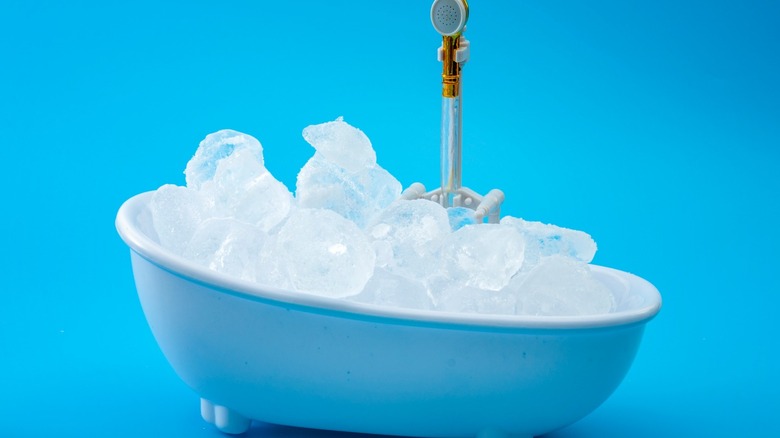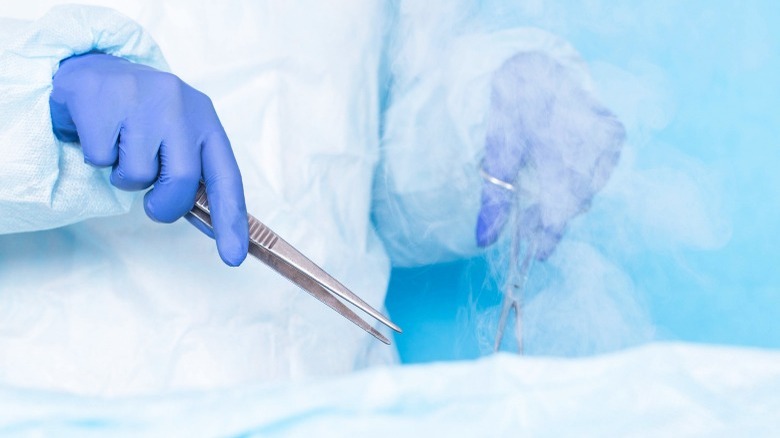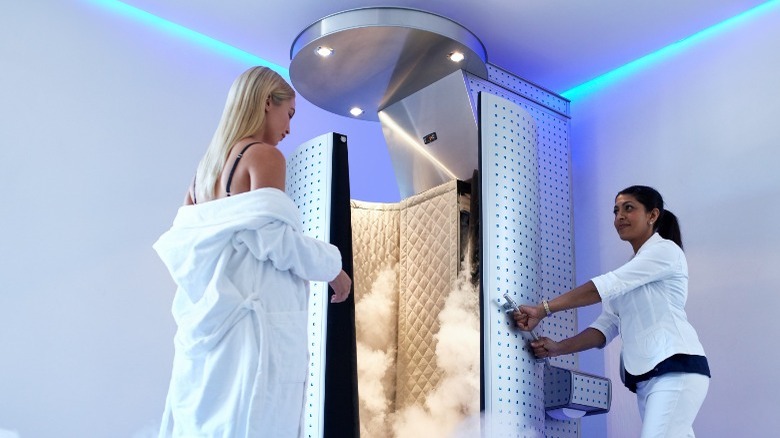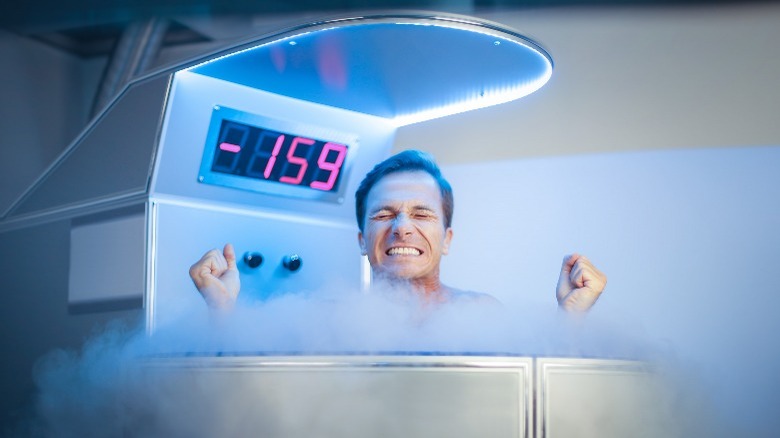Here's What Cryotherapy Can And Can't Do For You
Cryotherapy (sometimes referred to as cold therapy) is a form of medical therapy that works via the use of low temperatures. The process is quickly growing in popularity around the world — in fact, a new study predicts the cryotherapy market will only continue to grow over the next several years, per Market Research Insights.
Even though the ancient Egyptians used cold temperatures to tackle inflammation as early as 2500 B.C. (via a 2005 study published in the Dermatology Online Journal, posted by the University of California's eScholarship), the commercialized cryotherapy process we know in 2021 was discovered by Toshima Yamauchi, a Japanese medical doctor, in 1978 (via Inc.). Dr. Yamauchi was seeking a treatment for rheumatoid arthritis and found that rapid, short-term freezing was effective. However, the process has evolved since the late '70s, and by 2017 there were more than 400 cryotherapy treatment centers in the United States alone, according to The Week.
Cyrotherapy treatment can come in various forms, from cryosurgery to cryotherapy chambers. Depending on the issue being addressed, cryotherapy treatment might be right for you, although it's not the be-all-end-all to any health concern you have. However, despite its limitations, the results of treatment of some conditions seem quite promising. Here's what cryotherapy may or may not be able to do for you.
The ins and outs of cryosurgery
Even though the invention of modern cryotherapy treatment has been credited to Dr. Yamauchi (via Inc.), the concept behind cryosurgery has been in the realm of science since at least 1950, when Dr. Ray Allington used liquid nitrogen (which has a temperature of minus -196°C) in clinical practice to treat a number of nonneoplastic skin conditions, per a 2005 study published in the Dermatology Online Journal. The cryosurgery process in 2021 (sometimes known as cryoablation) isn't too far off from Dr. Allington's, with doctors still using substances like liquid nitrogen or argon gas to freeze and destroy abnormal tissue, both externally and internally (via Cleveland Clinic).
If you suffer from external skin conditions (i.e. warts or skin tags), then cryosurgery may be recommended to you by a doctor. In this type of treatment, the doctor will normally apply a freezing agent to the tissue using a spraying device or a cotton swab. If you are undergoing internal cryosurgery, then chances are your doctor is tackling precancerous (or even malignant tissue) associated with bone, cervical, liver, skin, or prostate cancer. Internal cryosurgery is done using an instrument called a cryoprobe, which is inserted into the skin through a small incision. An added bonus with cryosurgery is that it is usually done without open surgery and requires little downtime (per Cleveland Clinic).
Some benefits of cryotherapy chambers
Cryotherapy chambers (sometimes called cryo-saunas) are likely what most people think of when they hear the term "cryotherapy." Individual cryotherapy chambers work by encasing the body from the shoulders down in a metal tube, while the head remains outside in room temperature. The temperatures in individual cryosuanas drop to around minus -256 degrees Fahrenheit and the body remains encased for between a minute and a half to four minutes at a time. Group cryotherapy chambers consist of a walk-in room, where the temperatures range from -112 to -180 degrees. In this case the whole body (head included) is exposed to the cold temperatures (via The Week and Inc.). What exactly does this do to the body?
"The extreme cold experienced within a cryosauna stimulates sensors on the skin, activating a response from the central nervous system," Dr. Travis Utter, a physician and cryotherapy expert, told The Week. "Endorphins, which inhibit pain and elevate mood, are then released, while the strengthened blood circulation actually decreases inflammation, as toxins and metabolic waste are eliminated by a supply of oxygen and nutrient-enriched blood that stimulate cellular regeneration. This can lead to faster healing." In other words, cryotherapy chambers can help to relieve pain and inflammation, as well as promote better mental health by decreasing symptoms of anxiety and depression (via a small 2014 case study published by Psychology, Health, & Medicine, posted at Taylor & Francis Online). Furthermore, cryosaunas can allegedly help to promote weight-loss, according to The Week.
The limitations of cryosurgery and cryotherapy
Now that we know what cryotherapy and cryosurgery allegedly can do for you, it's time to explore what they cannot. Aside from both cryotherapy chambers and cryosurgery not being approved by the Food and Drug Administration (FDA), cryotherapy treatment studies are extremely limited and technically can neither be considered medical instruments, nor medical treatments for conditions such as cancer, obesity, depression, or for pain relief.
The U.S. Food and Drug Administration's exact words on cryotherapy chambers consisted of "this so-called 'treatment' hasn't been proved to do any of these things" and "not a single whole-body cryotherapy (WBC) device has been cleared or approved by the agency in support of these claims." The agency also noted some very serious potential risks, including asphyxiation, which can happen when liquid nitrogen is used for cooling (per ELLE in 2016).
Cryosurgery also has some limitations — it is not suitable for patients with certain skin-types, and cannot be used on certain types of lesions, according to Australian Family Physician. Another drawback of cryosurgery is that doctors are uncertain of how well it controls cancer, or how it affects the longevity of patients. Also, cryosurgery can only target tumors that can be seen by using imaging tests, according to the National Cancer Institute.



